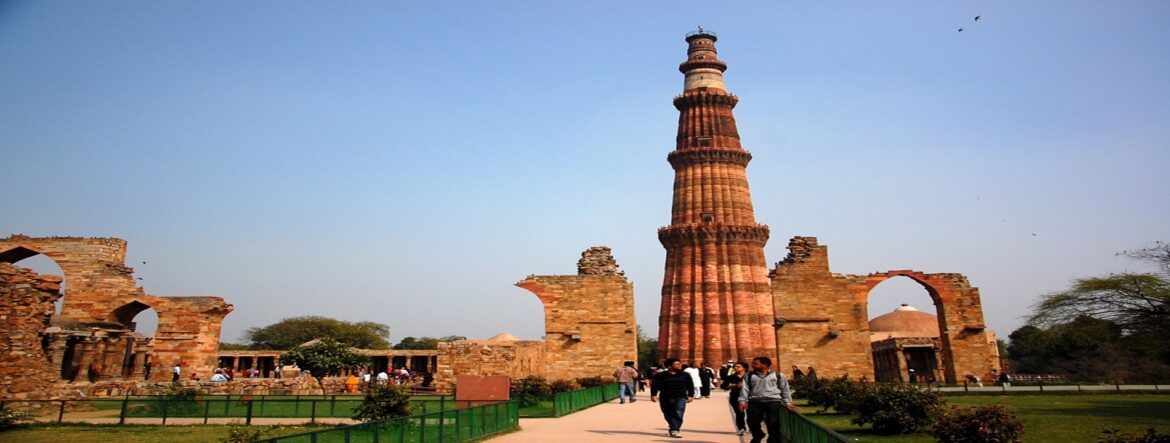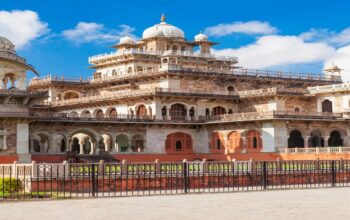For an immersive cultural and historical experience in India, consider embarking on a Golden Triangle tour. It’ll give you a peek into Delhi, Agra and Jaipur’s rich histories as you visit each. The Golden Triangle is India’s top travel destination, featuring incredible monuments and temples in each of the three cities forming it – all three are recognized as UNESCO World Heritage sites of Golden Triangle.
Red Fort Delhi
Red Fort Delhi is one of India’s most revered heritage monuments and a must-visit for any traveler. Built over time and standing the test of time, its beauty continues to enthrall visitors all year round. Furthermore, this fort boasts several museums dedicated to telling its history of Mughal rule in India.
Red Fort is an impressive fortress constructed of massive red sandstone walls enclosing an array of palaces and entertainment halls, projecting balconies, baths and indoor canals, geometric gardens and an ornate mosque – making it one of the must-visit tourist spots in Delhi. Recognized as a UNESCO World Heritage Site and considered one of the premier tourist destinations worldwide.
Shah Jahan ordered its construction in 1638, taking nearly 10 years for its completion under Ustad Hamid and Ustad Ahmad Lahauri as architects. Red Fort is a 256-acre structure situated along an octagonal-shaped walled fort featuring architectural styles from Islamic, Hindu and Timurid periods. It includes numerous turrets, bastions pavilions and gates.
At the Red Fort, two of the most celebrated buildings are the Hall of Public Audience (Diwan-i-Am) and Diwan-i-Khas, featuring intricate carvings and frescoes. During India’s struggle for freedom, Red Fort became a central site of protest and political unrest. People marched here in large numbers to show support for their country and fight colonialism; on Independence Day Pandit Jawaharlal Nehru gave a speech here which was broadcast across the nation via television.
Qutub Minar Delhi
Qutub Minar Delhi is one of India’s most celebrated heritage sites, located in its capital city and must-visit destination for first-time visitors to this great nation. This site, designated a UNESCO World Heritage Site by UNESCO, stands 240 ft tall and was constructed of red sandstone and marble by Qutb ud-din Aibak as part of his Mamluk Dynasty foundation and completed by Iltutmish after Aibak’s successor became ruler in 1525.
The tower stands as a symbol of victory and was constructed to mark Muslim invaders’ triumphant conquest over Hindus during early 13th century invasion by Muslim invaders from Arabia. As one of Delhi’s defining buildings, it has endured through time despite numerous historical changes; and is today part of Qutub complex. There are various inscriptions around the tower that detail its construction. Carved verses also adorn its interior.
This landmark stands as a symbolic representation of Indian architecture’s rich history and is an inspiration for numerous towers and minarets across India – for instance Mini Qutub Minar in West Delhi’s Hastaal village and Chand Minar in Daulatabad, Maharashtra are both named after it. Qutub Minar, designated a World Heritage Site by UNESCO, draws millions of tourists each year and serves as an icon for religion in Pakistan. Book Maharajas Express
Humayun’s Tomb Delhi
Humayun’s Tomb in Delhi is an internationally recognized monument that showcases Mughal architecture’s grandeur. A great spot for art and architecture enthusiasts as well as those interested in Indian history, its presence is worth experiencing first-hand. The Tomb is a UNESCO World Heritage site designed by Persian architect Mirak Mirza Ghiyas after Mughal Emperor Humayun’s death in 1556. Situated near Nizamuddin East in Delhi and on the banks of River Yamuna, it was the first garden tomb ever created in India.
Built on a seven-metre raised platform and completed in 1572, this tomb is surrounded by a large garden complex known as Char Bagh. These Persian style gardens boast four gardens that are connected by major walkways for easy access. There are also other monuments near the main tomb, including Isa Khan Tomb and Bu Halima Tomb as well as a mosque, as well as an important rest house for Arab master artisans working on it.
Humayun’s Tomb is an ideal spot for anyone interested in Mughal architecture and should be on every visitor’s itinerary in Delhi. A UNESCO World Heritage site that is open to the public, its magnificent red sandstone architecture makes this site one of India’s most captivating landmarks and makes an excellent photo op.
Taj Mahal Agra – One the top Heritage Sites of Golden Triangle
Agra draws millions of tourists each year and boasts one of the Seven Wonders of the World in Taj Mahal – an iconic monument visited by millions across the globe. The Taj Mahal was built by Mughal Emperor Shah Jahan as a lasting tribute to Mumtaz Mahal, his life-long love. To honor her memory he wanted a tomb built for her at which she could rest forever.
The Taj Mahal stands as an iconic symbol of love and beauty. Recognized by UNESCO as one of the greatest architectural feats ever, its exquisite details and intricate decorations have long been considered iconic worldwide. Although of immense beauty, the Taj Mahal faces numerous threats to its survival. Air pollution from nearby factories and road traffic poses the primary danger. Over time, this pollution causes its walls to turn yellow, eventually eroding them over time.
Pollution and wear and tear caused by the massive number of visitors are also serious concerns for the Taj. An increase in footfall has not only damaged its architecture but also altered the surrounding environment. To protect the beauty of the Taj, stringent environmental laws have been implemented in order to keep it from falling into ruin. This includes banning polluting vehicles from approaching near it as well as restricting new industrial development in Agra. Book Golden Triangle Tour Packages
Agra Fort – Another top Heritage Sites of Golden Triangle
Agra Fort is one of India’s most treasured heritage sites and UNESCO World Heritage sites, drawing tourists from across the world. Agra Fort is of immense historical significance due to its long and eventful history, having been altered over time by various rulers and empires. Originally constructed as a brick fort, Babur conquered and reconfigured Agra Fort as his personal property.
This fort was modified into a Mughal palace during its use by several emperors during their rule, changing its appearance and layout accordingly. Some of the most notable buildings within Agra Fort are Diwan-I-Am (Hall of Public Audience), Ghaznin Gate, Jahangiri Palace and Akbar’s Mahal. Each features an intriguing blend of Islamic and local Hindu architectural styles that gives these buildings their signature look.
Diwan-E-Khas was built around 1635 as the Royal Guest Hall. Here royal guests would meet and hold meetings. Additionally, cultural events were hosted here as well. Other notable buildings at Agra Fort are the Nagina Masjid and Shahjahani Mahal, both constructed using white marble as places of worship and considered private places of prayer.
Amber Fort – One of the top Heritage Sites of Golden Triangle
Amber Fort is one of the iconic sites on a Golden Triangle tour and located near Jaipur in Rajasthan. It consists of a vast palace complex featuring many palaces, courtyards and temples as well as gates and cobbled pathways that lead to it. The fort is composed of red sandstone and marble and has become a much-visited attraction since its creation by Raja Man Singh in 1592, later expanding by his son and grandson. Additionally, it is listed on UNESCO’s World Heritage Site list.
History-wise, it has an ardent past of treachery and bloodshed that spans centuries. Today it remains an integral center for political processes. Amber Fort is a vast palace constructed out of sandstone and marble that sits atop a hill in India’s Amber region, and recognized by UNESCO as an iconic World Heritage site. The Palace consists of four courtyards, palaces and halls built using sandstone and marble, connected by four moats for added charm. An ideal destination to spend quality time with family or friends!
Fort Jaipur is one of Jaipur’s top attractions and can be explored daily from 8 am to 5:30 pm from 8 am onwards, whether by foot, elephant, jeep, golf cart or guided tour. Nighttime visits should also be considered when it will light up with an impressive sound and light show!




